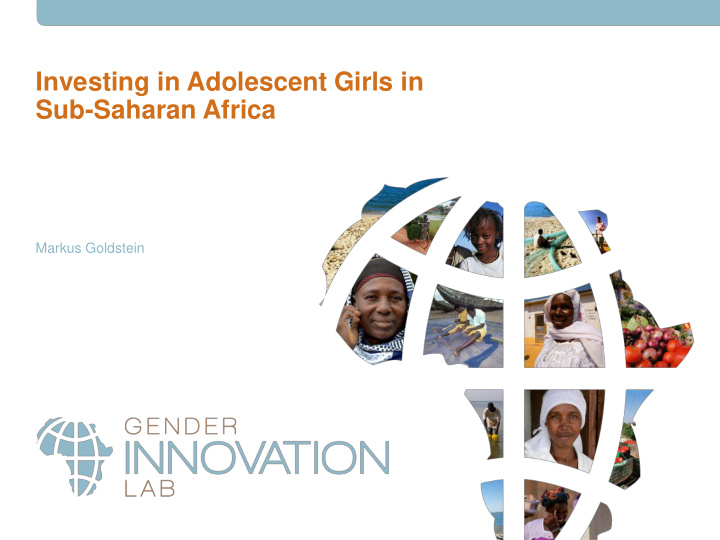



Investing in Adolescent Girls in Sub-Saharan Africa Markus Goldstein
Opportunities? Fact 1: Lots of youth
Opportunities? Fact 2 : Girls are less likely to Fact 1 : Lots of youth be working
Opportunities? Fact 2 : Girls are less likely to Fact 1 : Lots of youth be working Fact 3 : they are having more children, younger
For girls, adolescence is the critical time to intervene • Risk of HIV/STI, unintended pregnancy • Early motherhood can limit future earnings (path dependence) • Barriers to labor market entry – smaller networks/access to information – domestic work burden – concurrent labor market/fertility decisions.
So how about a program that targets girls? • Think about ways to facilitate the school to work transition 1. Need to take into account constraints unique to girls 2. Possibility of multi-dimensional intervention – not just job training, but other skills – both in their daily life (e.g. health) and “soft skills” for jobs
What do we know? • Youth Employment literature: 2 meta-analyses – Some, but not a lot of impact, not that much rigorous evaluation, some more positive impacts for women • IDB review by Ibarraran and Schady (2009) and WB’s Youth Employment Inventory (Betcherman 2007) • Girls Empowerment literature: 1 meta-analysis – less rigorous analysis, not a lot of impact reported on economic outcomes • DFID review by Dickson Bangpan (2012) Large question of impacts/functioning across contexts
1. EPAG - Liberia • $4m, funded through WB AGI • Target girls age 16-27 with: 1. Job or Business Skills training (6 months) 2. Placement/start-up support (6 months) 3. Life skills, e.g., communication, leadership, GBV. • Led by Ministry of Gender, implemented by NGOs
2. ELA - Uganda • Run by BRAC, funded by Mastercard & Nike • Target girls 14-20 with: 1. Safe social space 2. Life skills training (focus on reproductive health) 3. Short livelihood training based on local market 4. In future: microfinance
How will we know if it works? • Why evaluate? – Girl space filled with lots of advocacy, but what about rigorous evidence on what works, what are the payoffs? • Our approach: randomized control trials – Liberia: phase-in, 1300 girls in the first wave – Uganda: 100 villages in program, 50 in control
So, we collected lots of data • Uganda: 4888 girls, 2 interviews, 2 years apart • Liberia: 1620 girls, 2 interviews, 1 year apart • Wide range of outcomes: not just employment but also: self-confidence, savings, expenditures, health, GBV, time use, etc.
Did it work? Liberia In terms of employment and earnings: Employment 47% Earnings 32 USD per month (80%) • Stronger effects for Business Skills trainees than for Job Skills trainees Savings by 36 USD
Did it work? Uganda Employment and earnings outcomes: Engagement in IGAs by 72% • Driven by self-employment activities Spending on themselves by 38% No adverse effects on schooling outcomes, e.g. enrollment or time spent on studying
Impacts beyond economics in Uganda Fertility: reported motherhood decreases by 26% Proportion of those always using a condom increases by 26% No effect on use of other contraceptives or reported STDs Incidence of sex against their will drops by 41%
And changing gender roles in Uganda
Impacts beyond economics in Liberia No impact on fertility – actual or desired No impacts on contraception, # of boyfriends, incidence of GBV Positive impacts on self confidence, satisfaction with job outcomes
Is it worth it? Liberia • Cost per beneficiary: – 1650 USD for Job Skills track – 1200 USD for Business Skills track • Compare to 700-2000 USD for Jovenes programs in Latin America • Set this against average monthly increase in earnings: – 2 years to recoup investment (Business Skills) – 8 years to recoup investment (Job Skills)
Is it worth it? Uganda • Cost per potential beneficiary is $17.9 in year 2 • Corresponds to – .54% of hh income at baseline – 21% of a girl’s self -reported annual expenditures • Set this against: – increase in employment – lower fertility – drop in sex against her will
Do these experiences translate to other contexts? • Ongoing analysis of data from South Sudan – ELA program implemented before the 2013 conflict – Results will let us look at household level exposure to conflict and how girls fared with, and without, the program • Ongoing early analysis from Sierra Leone – Program interrupted by Ebola epidemic (then continued) – Analysis will allow us to look at ELA program components (is it the skill training? Microfinance? Club space?) – And we will be able to look at Ebola affected households & communities versus those without to see the epidemic shifted the trajectory of program impacts
This is based on work by a bunch of folks • Liberia: Franck Adoho, Mattias Lundberg, Dala T. Korkoyah Jr., Afia Tasneem, plus the Bank task team (AFRHD and PRMGE) and Ministry of Gender and Development • Uganda: Oriana Bandiera, Niklas Buehren, Robin Burgess, Selim Gelusci, Markus Goldstein, Imran Rasul, Munshi Sulaiman, plus the BRAC Uganda country team
www.worldbank.org/en/programs /africa-gender-innovation-lab
Recommend
More recommend